Croconic Acid Doped Triglycine Sulfate: Crystal Structure, UV-Vis, FTIR, Raman, Photoluminescence Spectroscopy, and Dielectric Properties
Abstract
:1. Introduction
2. Materials and Methods
2.1. Single Crystal XRD
2.2. Powder XRD
3. Results and Discussion
3.1. Single Crystal XRD Analysis
3.2. Powder XRD Analysis
3.2.1. X-ray Phase Analysis
3.2.2. Microstructure Parameters from the Analysis of the Profiles of XRD Reflections
3.2.3. Rietveld Analysis
3.3. Raman Spectroscopy
3.4. FTIR
3.5. UV-Vis Absorption
3.6. Photoluminescence
3.7. Dielectric Properties
4. Conclusions
Supplementary Materials
Author Contributions
Funding
Institutional Review Board Statement
Informed Consent Statement
Data Availability Statement
Acknowledgments
Conflicts of Interest
References
- Matthias, B.T.; Miller, C.E.; Remeika, J.P. Ferroelectricity of glycine sulfate. Phys. Rev. 1956, 104, 849–850. [Google Scholar] [CrossRef]
- Fleck, M.; Petrosyan, A.M. Salts of amino acids. Crystallization, Structure and Properties; Springer International Publishing: Cham, Switzerland, 2014. [Google Scholar]
- Lal, R.B.; Batra, A.K. Growthl and properties of triglycine sulfate (TGS) crystals: Review. Ferroelectrics 1993, 142, 51–82. [Google Scholar] [CrossRef]
- Miga, S.; Dec, J.; Ćwikiel, K. Temperature dependences of nonlinear dielectric susceptibilities of triglycine sulphate near ferroelectric phase transition. Phase Transit. 2007, 80, 95–99. [Google Scholar] [CrossRef]
- Miga, S.; Dec, J. Non-linear dielectric response of ferroelectric and relaxor materials. Ferroelectrics 2008, 367, 223–228. [Google Scholar] [CrossRef]
- Whatmore, R.W. Pyroelectric devices and materials. Rep. Prog. Phys. 1986, 49, 1335–1386. [Google Scholar] [CrossRef]
- Shut, V.N.; Kashevich, I.F. Formation of the unipolar state in hydrogenous ferroelectric crystals. Ferroelectrics 2007, 350, 57–64. [Google Scholar] [CrossRef]
- Sidorkin, A.S.; Milovidova, S.D.; Rogazinskaya, O.V.; Sidorkin, A.A. Internal bias field in TGS crystals doped with different impurities. Crystallogr. Rep. 2004, 49, 130–133. [Google Scholar] [CrossRef]
- Choudhury, R.R.; Chitra, R.; Ramanadham, M.; Jayavel, R. Prevention of depoling in TGS by alanine substitution: An interpretation based on a neutron-diffraction study. Appl. Phys. A Mater. Sci. Process. 2002, 74, 1667–1669. [Google Scholar] [CrossRef]
- Krishnakumar, V.; Sivakumar, S.; Nagalakshmi, R.; Bhuvaneswari, S.; Rajaboopathi, M. Effect of doping an organic molecule ligand on TGS single crystals. Spectrochim. Acta A 2008, 71, 480–485. [Google Scholar] [CrossRef]
- Sinha, N.; Goel, N.; Singh, B.K.; Gupta, M.K.; Kumar, B. Enhancement in ferroelectric, pyroelectric and photoluminescence properties in dye doped TGS crystals. J. Solid State Chem. 2012, 190, 180–185. [Google Scholar] [CrossRef]
- Alexandru, H.V.; Berbecaru, C.; Ion, L.; Dutu, A.; Ion, F.; Pintilie, L.; Radulescu, R.C. Pyroelectric coefficient manipulation in doped TGS crystals. Appl. Surf. Sci. 2006, 253, 358–362. [Google Scholar] [CrossRef]
- Saxena, A.; Gupta, V.; Sreenivas, K. Characterization of phosphoric acid doped TGS single crystals. J. Cryst. Growth. 2004, 263, 192–202. [Google Scholar] [CrossRef]
- Belugina, N.V.; Gainutdinov, R.V.; Tolstikhina, A.L.; Ivanova, E.S.; Kashevich, I.F.; Shut, V.N.; Mozzharov, S.E. Formation of a regular domain structure in TGS–TGS + Cr crystals with a profile impurity distribution. Crystallogr. Rep. 2015, 60, 555–560. [Google Scholar] [CrossRef]
- Sivanesan, G.; Kolandaivel, P.; Pandian, S.S. Laser Raman and FT-IR studies of pure and Zn-doped TGS. Mater. Chem. Phys. 1993, 34, 73–77. [Google Scholar] [CrossRef]
- Mahendra, K.; Kumar, H.K.T.; Udayashankar, N.K. Enhanced structural, optical, thermal, mechanical and electrical properties by a noval approach (nanoparticle doping) on ferroelectric triglycine sulphate single crystal. Appl. Phys. A. 2019, 125, 228. [Google Scholar] [CrossRef]
- Raghavan, C.M.; Sankar, R.; Mohan Kumar, R.; Jayavel, R. Effect of amino acid doping on the growth and ferroelectric properties of triglycine sulphate single crystals. Mater. Res. Bull. 2008, 43, 305–311. [Google Scholar] [CrossRef]
- Stadnyk, V.Y.; Romanyuk, N.A.; Kiryk, Y.I. Optical properties of TGS crystal with L- valine admixture. Crystallogr. Rep. 2010, 55, 995–999. [Google Scholar] [CrossRef]
- Meera, K.; Muralidharan, R.; Santhanaraghavan, P.; Gopalakrishnan, R.; Ramasamy, P. Growth and characterization of L-cystine doped TGS crystals. J. Cryst. Growth. 2001, 226, 303–312. [Google Scholar] [CrossRef]
- Singh, P.; Abdullah, M.M.; Sagadevan, S.; Ikram, S. Enhancement of electro-optic and structural properties of TGS single crystals on doping with l-glutamic acid. J. Mater. Sci. Mater. Electron. 2018, 29, 7904–7916. [Google Scholar] [CrossRef]
- Deepthi, P.R.; Shanthi, J. Optical, dielectric & ferroelectric studies on amino acids doped TGS single crystals. RSC Adv. 2016, 6, 33686–33694. [Google Scholar] [CrossRef]
- Batra, A.K.; Alomari, A.; Guggilla, P.; Brown, D.; Kamara, O.; Lal, R.B. Growth and Optical Characterization of Doped Triglycine Sulfate (TGS) Crystals. Adv. Sci. Eng. Med. 2016, 8, 689–694. [Google Scholar] [CrossRef]
- Hussain, A.; Sinha, N.; Joseph, A.J.; Goel, S.; Singh, B.; Bdikin, I.; Kumar, B. Mechanical investigations on piezo-/ferrolectric maleic acid-doped triglycine sulphate single crystal using nanoindentation technique. Arab. J. Chem. 2020, 13, 1874–1889. [Google Scholar] [CrossRef]
- Begum, S.N.; Sankar, U. Studies on Optical and Mechanical Properties of Salicylic acid Admixtured TGS Single Crystals. Available online: http://www.ijtrd.com/papers/IJTRD15969.pdf (accessed on 8 April 2022).
- Rai, C.; Narayana Moolya, B.; Dharmaprakash, S.M. Iminodiacetic acid doped ferroelectric triglycine sulphate crystal: Crystal growth and characterization. Phys. B Condens. Matter. 2011, 406, 1–7. [Google Scholar] [CrossRef]
- Rai, C.; Sreenivas, K.; Dharmaprakash, S.M. Growth of 4-(dimethylamino) benzaldehyde doped triglycine sulphate single crystals and its characterization. Phys. B Condens. Matter 2009, 404, 3886–3889. [Google Scholar] [CrossRef]
- Rajesh, P.; Rao, G.B.; Ramasamy, P. Effect of Rochelle salt on growth, optical, photoluminescence, photoconductive and piezoelectric properties of the triglycine sulphate single crystal. J. Cryst. Growth. 2017, 468, 340–344. [Google Scholar] [CrossRef]
- Parimaladevi, R.; Sekar, C.; Krishnakumar, V. The effect of nitric acid (HNO3) on growth, spectral, thermal and dielectric properties of triglycine sulphate (TGS) crystal. Spectrochim. Acta A 2010, 75, 617–623. [Google Scholar] [CrossRef]
- Deepti, P.R.; Shanti, J. Structural and Optical Studies of Potential Ferroelectric Crystal: KDP Doped TGS. J. Sci. Res. 2013, 6, 1–9. [Google Scholar] [CrossRef] [Green Version]
- Das, H.N.; Podder, J. Growth, structural, optical and microhardness study of KCl doped triglycine sulphate (TGS) crystals for photonic applications. J. Optoelectron. Adv. Mater. 2013, 15, 1142–1146. [Google Scholar]
- Malekfar, R.; Daraei, A. Raman Scattering and Electrical Properties of TGS: PCo (9 %) Crystal as Ambient Temperature IR Detector. Acta Phys. Pol. A. 2008, 114, 859–867. [Google Scholar] [CrossRef]
- Khanum, F.; Podder, J. Crystallization and Characterization of Triglycine Sulfate (TGS) Crystal Doped with NiSO4. J. Cryst. Process Technol. 2011, 1, 49–54. [Google Scholar] [CrossRef] [Green Version]
- Sinha, N.; Bhandari, S.; Yadav, H.; Ray, G.; Godara, S.; Tyagi, N.; Dalal, J.; Kumara, S.; Kumar, B. Performance of crystal violet doped triglycine sulfate single crystals for optical and communication applications. CrystEngComm. 2015, 17, 5757–5767. [Google Scholar] [CrossRef]
- Khanum, F.; Podder, J. Synthesis, growth, and electrical transport properties of pure and LiSO4-doped triglycine sulphate crystal. Int. J. Opt. 2012, 2012, 1–7. [Google Scholar] [CrossRef] [Green Version]
- Krajewski, T.; Breczewski, T. Dielectric and pyroelectric properties of tgs crystals doped with nitroaniline molecules. Ferroelectrics 1980, 25, 547–550. [Google Scholar] [CrossRef]
- Washino, M.; Yamada, K.; Kurita, Y. The Dipole Moments and Molecular Structures of Croconic Acid and Dimethyl Croconate. Bull. Chem. Soc. Jpn. 1958, 31, 552–555. [Google Scholar] [CrossRef] [Green Version]
- Horiuchi, S.; Kagawa, F.; Hatahara, K.; Kobayashi, K.; Kumai, R.; Murakami, Y.; Tokura, Y. Above-room-temperature ferroelectricity in a single-component molecular crystal. Nature 2010, 463, 789–792. [Google Scholar] [CrossRef] [PubMed]
- Horiuchi, S.; Kobayashi, K.; Kumai, R.; Ishibashi, S. Proton tautomerism for strong polarization switching. Nat. Commun. 2017, 8, 14426. [Google Scholar] [CrossRef] [PubMed]
- Sawada, R.; Uemura, H.; Sotome, M.; Yada, H.; Kida, N.; Iwano, K.; Shimoi, Y.; Horiuchi, S.; Okamoto, H. Large second-order optical nonlinearity in a ferroelectric molecular crystal of croconic acid with strong intermolecular hydrogen bonds. Appl. Phys. Lett. 2013, 102, 162901. [Google Scholar] [CrossRef]
- Encinas, C.; Otazo, E.; Rivera, L.; Miltsov, S.; Alonso, J. Croconines: New acidochromic dyes for the near infrared region. Tetrahedron Lett. 2002, 43, 8391–8393. [Google Scholar] [CrossRef]
- Prabhakar, C.; Tripathi, A.; Bhanuprakash, K.; Jayathirtharao, V. Visible absorbing croconium dyes with intramolecular hydrogen bonding: A combined experimental and computational study. J. Mol. Struct. 2017, 1146, 684–691. [Google Scholar] [CrossRef]
- Kitova, S.; Stoyanova, D.; Dikova, J.; Vassilev, A.; Kandinska, M.; Angelova, S. Optical Properties of Thin Films of New Croconium Dye for Application in Organic Solar Cells. Nanosci. Nanotech. 2014, 14, 70–73. [Google Scholar]
- Feng, S.; Yang, H.; Jiang, X.; Wang, Y.; Zhu, M. A new 3D silver(I) coordination polymer with croconate ligand displaying green luminescent. J. Mol. Struct. 2015, 1081, 1–5. [Google Scholar] [CrossRef]
- Miller, D.P.; Costa, P.S.; Teeter, J.D.; Sinitskii, A.; Enders, A.; Hooper, J.G.M. Seeking out Heterogeneous Hydrogen Bonding in a Self-Assembled 2D Cocrystal of Croconic Acid and Benzimidazole on Au(111). J. Phys. Chem. C. 2021, 125, 2403–2410. [Google Scholar] [CrossRef]
- Braga, D.; Maini, L.; Grepioni, F. Crystallization from hydrochloric acid affords the solid-state structure of croconic acid (175 years after its discovery) and a novel hydrogen-bonded network. CrystEngComm 2001, 3, 27. [Google Scholar] [CrossRef]
- Sheldrick, G.M. A short history of SHELX. Acta Crystallogr. A 2008, 64, 112–122. [Google Scholar] [CrossRef] [Green Version]
- Dolomanov, O.V.; Bourhis, L.J.; Gildea, R.J.; Howard, J.A.K.; Puschmann, H. OLEX2: A complete structure solution, refinement and analysis program. J. Appl. Crystallogr. 2009, 42, 339–341. [Google Scholar] [CrossRef]
- Diffrac Suite Eva Version 5.1.0.5; Bruker: Karlsruhe, Germany, 2019.
- Powder Diffraction File-2; International Centre for Diffraction Data (ICDD): Newatown Square, PA, USA, 2014.
- Kraus, W.; Nolze, G. POWDER CELL-A program for the representation and manipulation of crystal structures and calculation of the resulting X-ray powder patterns. J. Appl. Crystallogr. 1996, 29, 301–303. [Google Scholar] [CrossRef]
- Maunders, C.; Etheridge, J.; Wright, N.; Whitfield, H.J. Structure and microstructure of hexagonal Ba3Ti2RuO9 by electron diffraction and microscopy. Acta Crystallogr. B 2005, 61, 154–159. [Google Scholar] [CrossRef] [Green Version]
- Terlan, B.; Levin, A.A.; Börrnert, F.; Simon, F.; Oschatz, M.; Schmidt, M.; Cardoso-Gil, R.; Lorenz, T.; Baburin, I.A.; Joswig, J.-O.; et al. Effect of Surface Properties on the Microstructure, Thermal, and Colloidal Stability of VB2 Nanoparticles. Chem. Mater. 2015, 27, 5106–5115. [Google Scholar] [CrossRef]
- Levin, A.A. Program SizeCr for Calculation of the Microstructure Parameters from X-ray Diffraction Data. Preprint. Available online: https://www.researchgate.net/profile/Alexander-Levin-6/research (accessed on 29 March 2022). [CrossRef]
- Diffrac Suite TOPAS Version 5; Technical reference; Bruker: Karlsruhe, Germany, 2014.
- Dollase, W.A. Correction of Intensities of Preferred Orientation in Powder Diffractometry: Application of the March Model. J. Appl. Crystallogr. 1986, 19, 267–272. [Google Scholar] [CrossRef]
- Jarvinen, M. Application of symmetrized harmonics expansion to correction of the preferred orientation effect. J. Appl. Crystallogr. 1993, 26, 525–531. [Google Scholar] [CrossRef]
- Levin, A.A. Program RietESD for Correction of Estimated Standard Deviations Obtained in Rietveld-Refinement Program. Preprint. Available online: https://www.researchgate.net/profile/Alexander-Levin-6/research (accessed on 29 March 2022). [CrossRef]
- Bérar, J.-F.; Lelann, P. ESD’s and Estimated Probable Error Obtained in Rietveld Refinements with Local Correlations. J. Appl. Crystallogr. 1991, 24, 1–5. [Google Scholar] [CrossRef]
- Momma, K.; Izumi, F. VESTA 3 for three-dimensional visualization of crystal, volumetric and morphology data. J. Appl. Crystallogr. 2011, 44, 1272–1276. [Google Scholar] [CrossRef]
- Balashova, E.V.; Svinarev, F.B.; Zolotarev, A.A.; Levin, A.A.; Brunkov, P.N.; Davydov, V.Y.; Smirnov, A.N.; Redkov, A.V.; Pankova, G.A.; Krichevtsov, B.B. Crystal structure, raman spectroscopy and dielectric properties of new semiorganic crystals based on 2-methylbenzimidazole. Crystals 2019, 9, 573. [Google Scholar] [CrossRef] [Green Version]
- Balashova, E.; Levin, A.A.; Fokin, A.; Redkov, A.; Krichevtsov, B. Structural Properties and Dielectric Hysteresis of Molecular Organic Ferroelectric Grown from Different Solvents. Crystals 2021, 11, 1278. [Google Scholar] [CrossRef]
- Choudhury, R.R.; Chitra, R. Single crystal neutron diffraction study of triglycine sulphate revisited. PRAMANA 2008, 71, 911–915. [Google Scholar] [CrossRef]
- Hill, R.J.; Fischer, R.X. Profile agreement indices in rietveld and pattern-fitting analysis. J. Appl. Crystallogr. 1990, 23, 462–468. [Google Scholar] [CrossRef]
- Krishnan, R.S.; Balasubramanian, K. Raman Spectrum of Crystalline Tri-Glycine Sulphate. Proc. Ind. Acad. Sci. 1958, 48, 138–144. [Google Scholar] [CrossRef]
- Jimin, Z.; Gouxiang, L.; Bing, L.; Shifen, H.; Huafu, W. Raman studies of the tgs-tgfb system and its ferroelectric phase transition. Ferroelectrics 1990, 101, 251–259. [Google Scholar] [CrossRef]
- Erdle, E.; Möhwald, H. Mini-Excitons and Lattice Dynamics in Mixed CT-Crystals: An ESR, Optical and Raman Spectroscopical Study. Z. Naturforsch. A 1980, 35, 236–243. [Google Scholar] [CrossRef] [Green Version]
- Kolev, T.; Koleva, B.B.; Spiteller, M. Solid-state linear polarized IR-spectroscopy of croconic and rhodizonic acids. Cent. Eur. J. Chem. 2008, 6, 393–399. [Google Scholar] [CrossRef]
- Kasap, S.; Capper, P. (Eds.) Springer Handbook of Electronic and Photonic Materials, 2nd ed.; Springer International Publishing AG: Cham, Switzerland, 2017. [Google Scholar]
- Pankove, J.I. Optical Processes in Semiconductors; Dover Publications: New York, NY, USA, 2012. [Google Scholar]
- Balashova, E.V.; Krichevtsov, B.B.; Lemanov, V.V. Permittivity and conductivity of triglycine sulfate films on Al/SiO2 and α-Al2O3 substrates. Phys. Solid State. 2010, 52, 126–131. [Google Scholar] [CrossRef]
- Balashova, E.V.; Krichevtsov, B.B.; Lemanov, V.V. Growth, Optical Imaging and Dielectric Properties of Ferroelectric Betaine Phosphite and Triglycine Sulphate Films. Integr. Ferroelectr. 2009, 106, 29–39. [Google Scholar] [CrossRef]
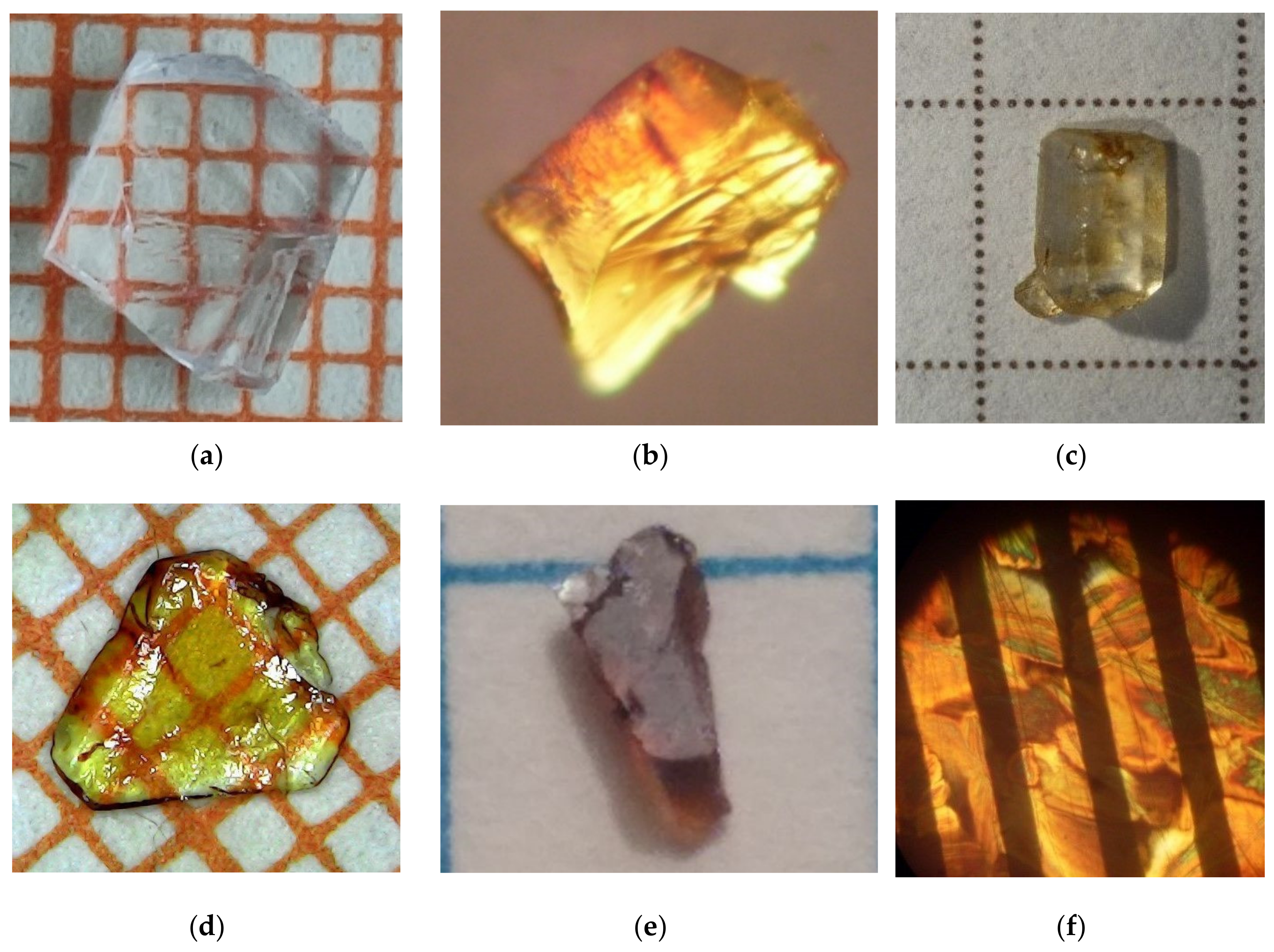
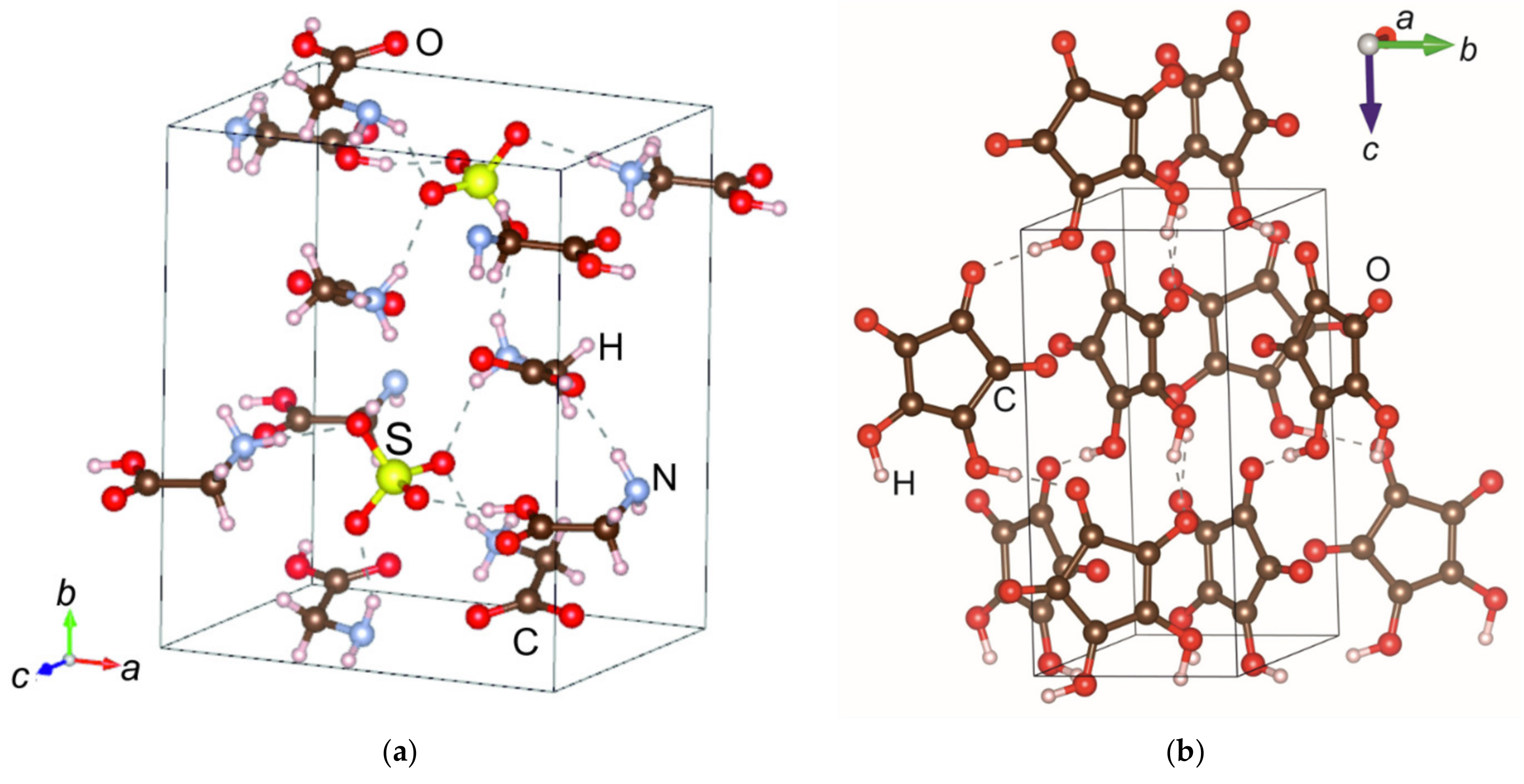
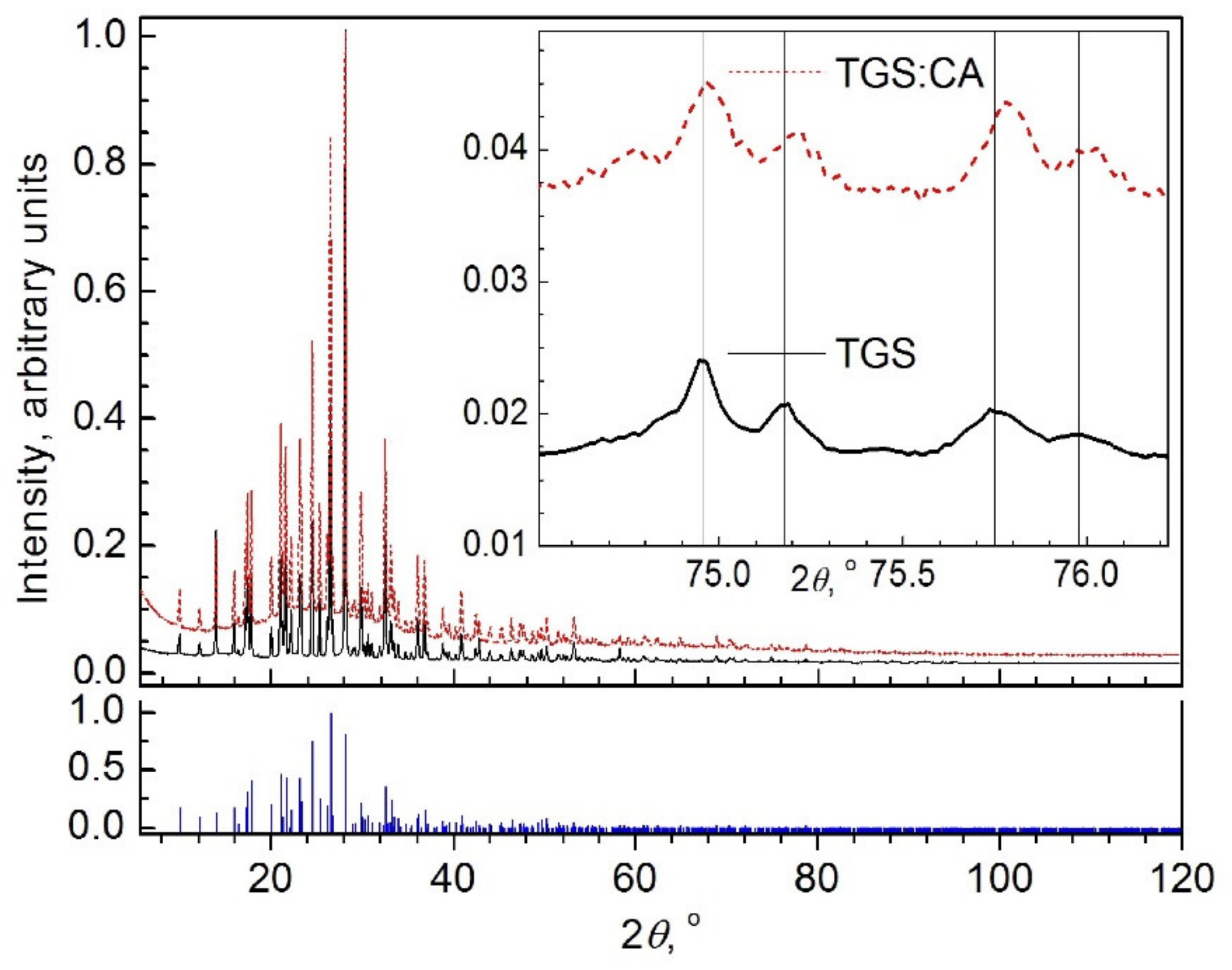
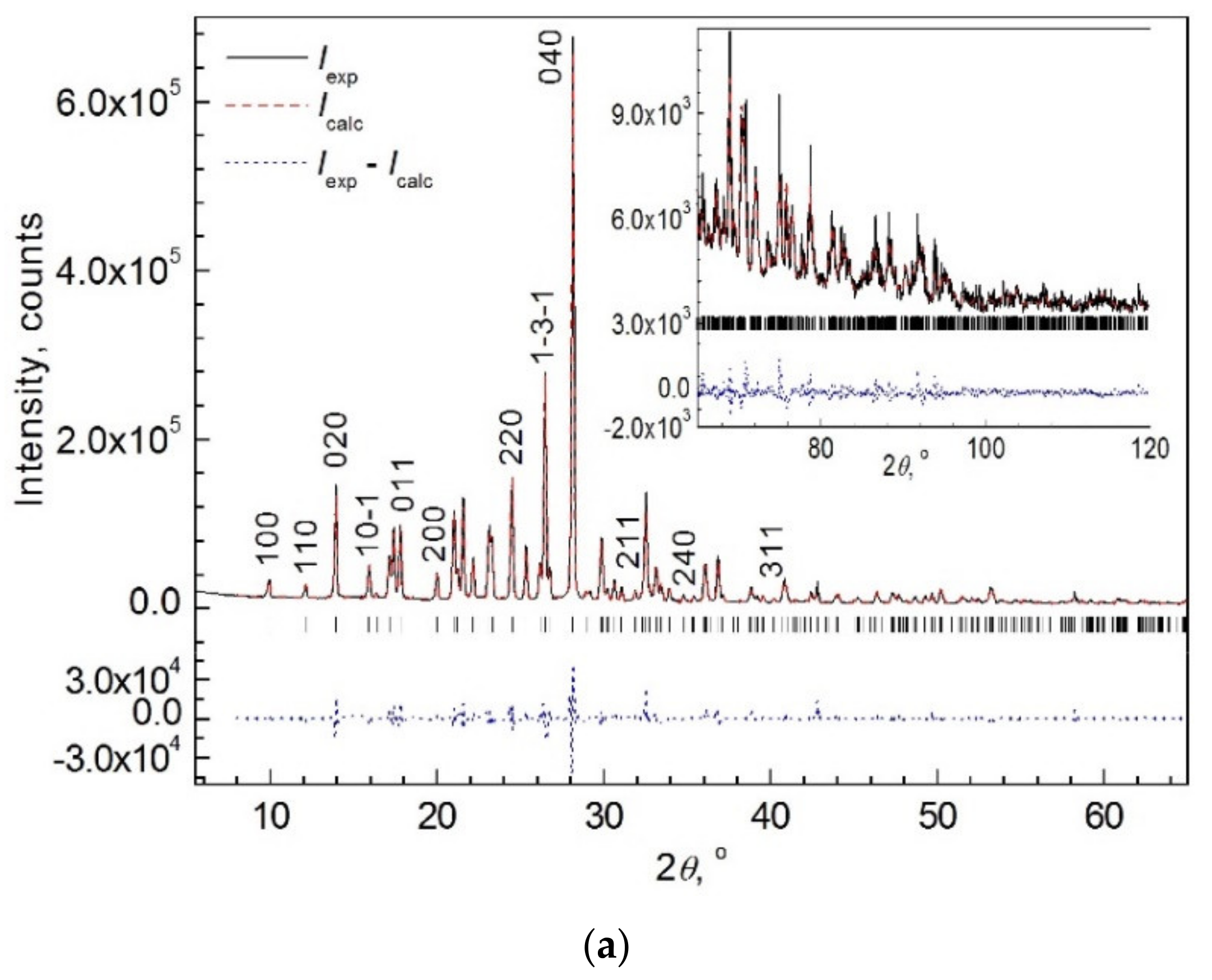
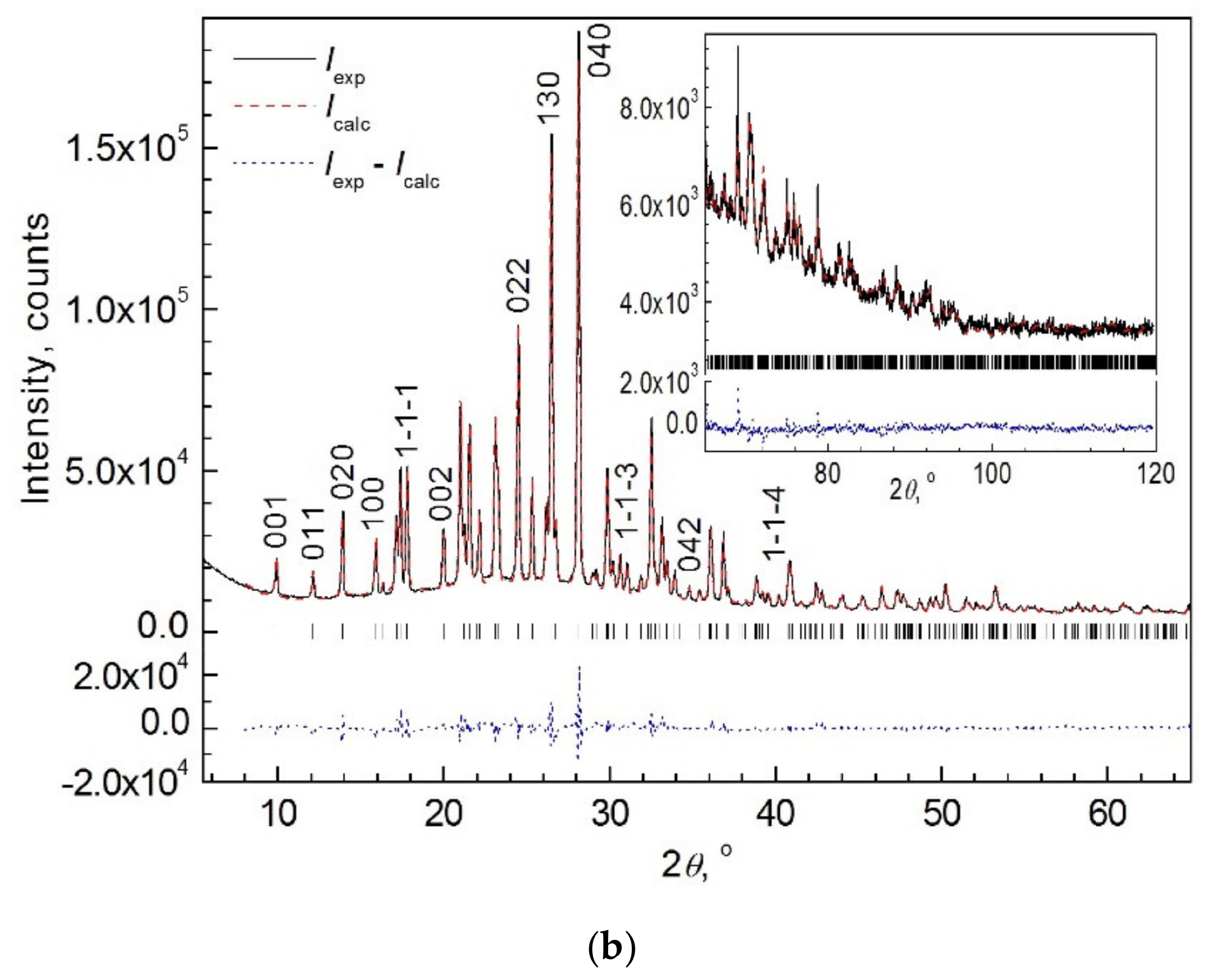
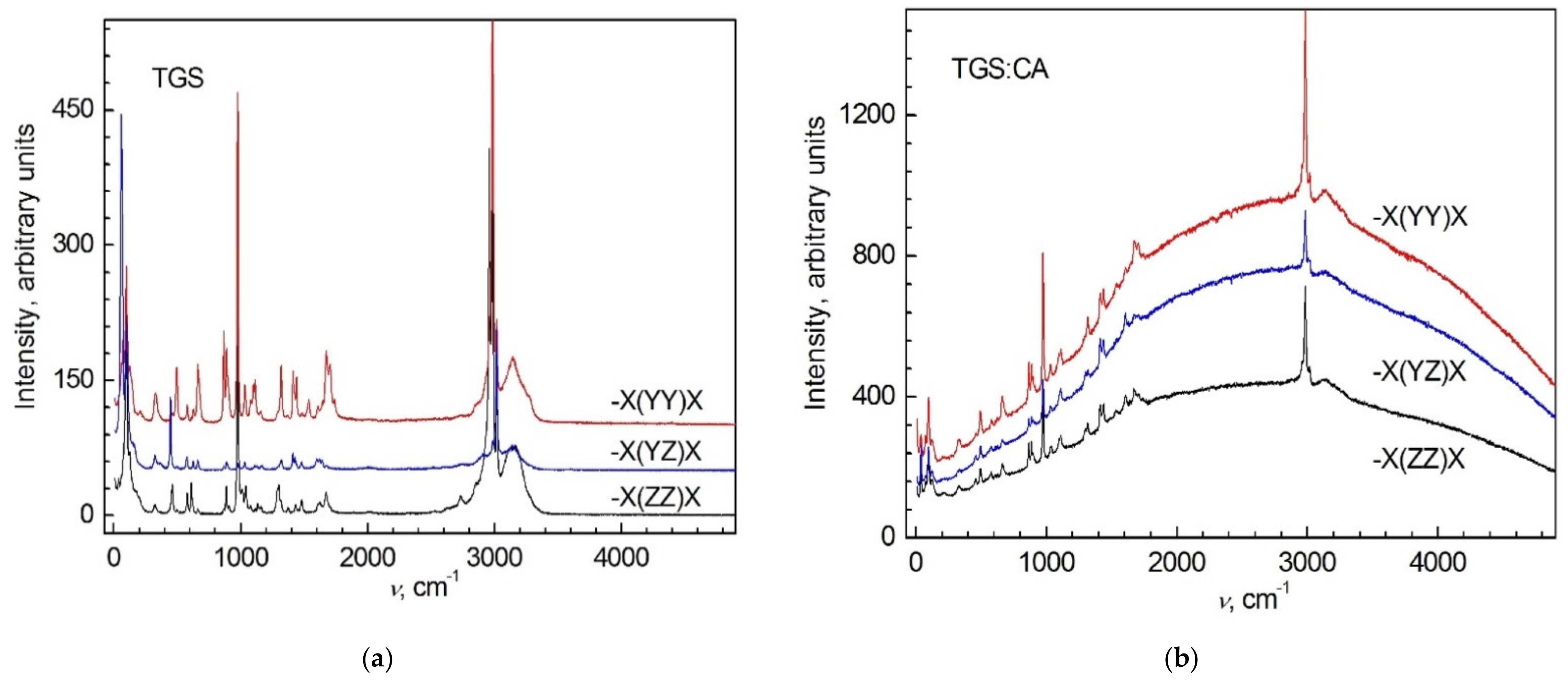
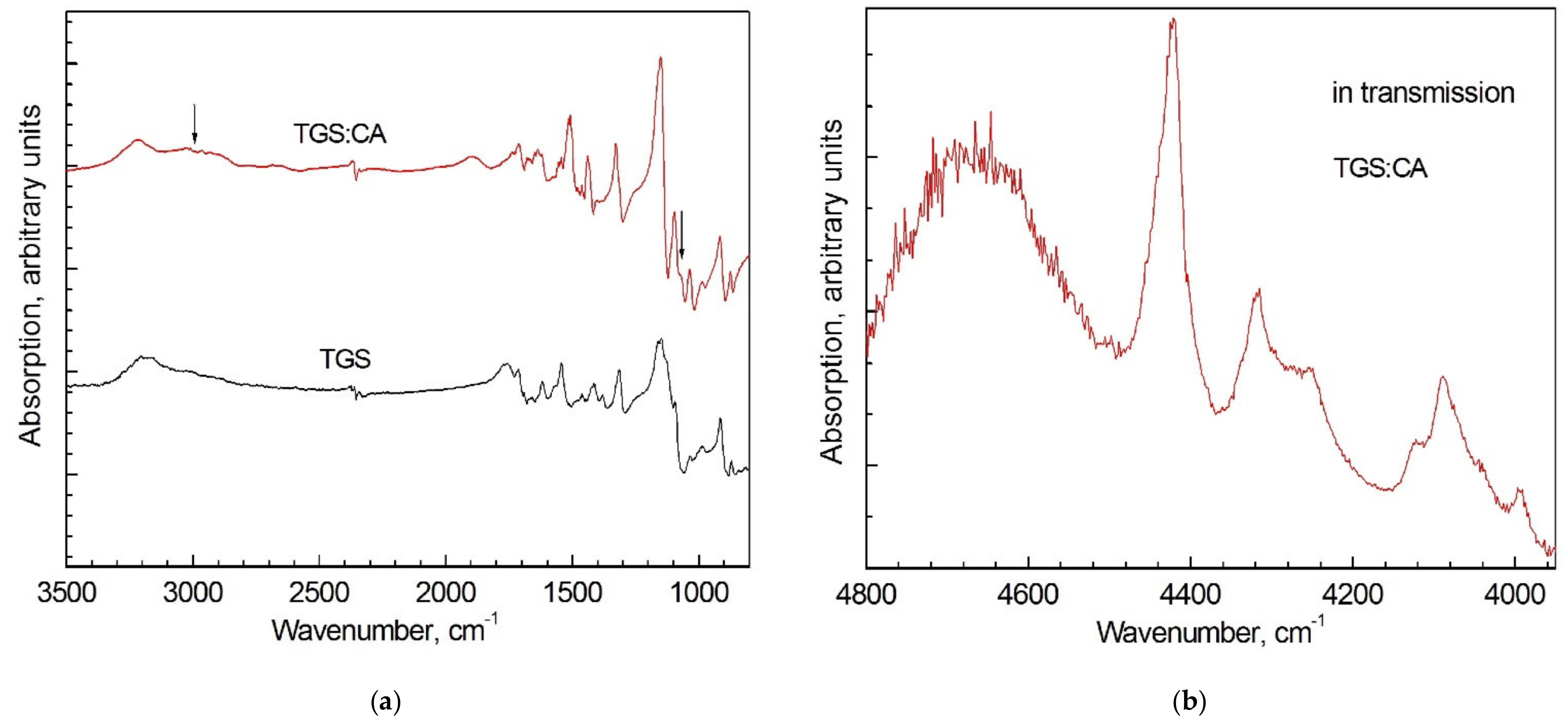
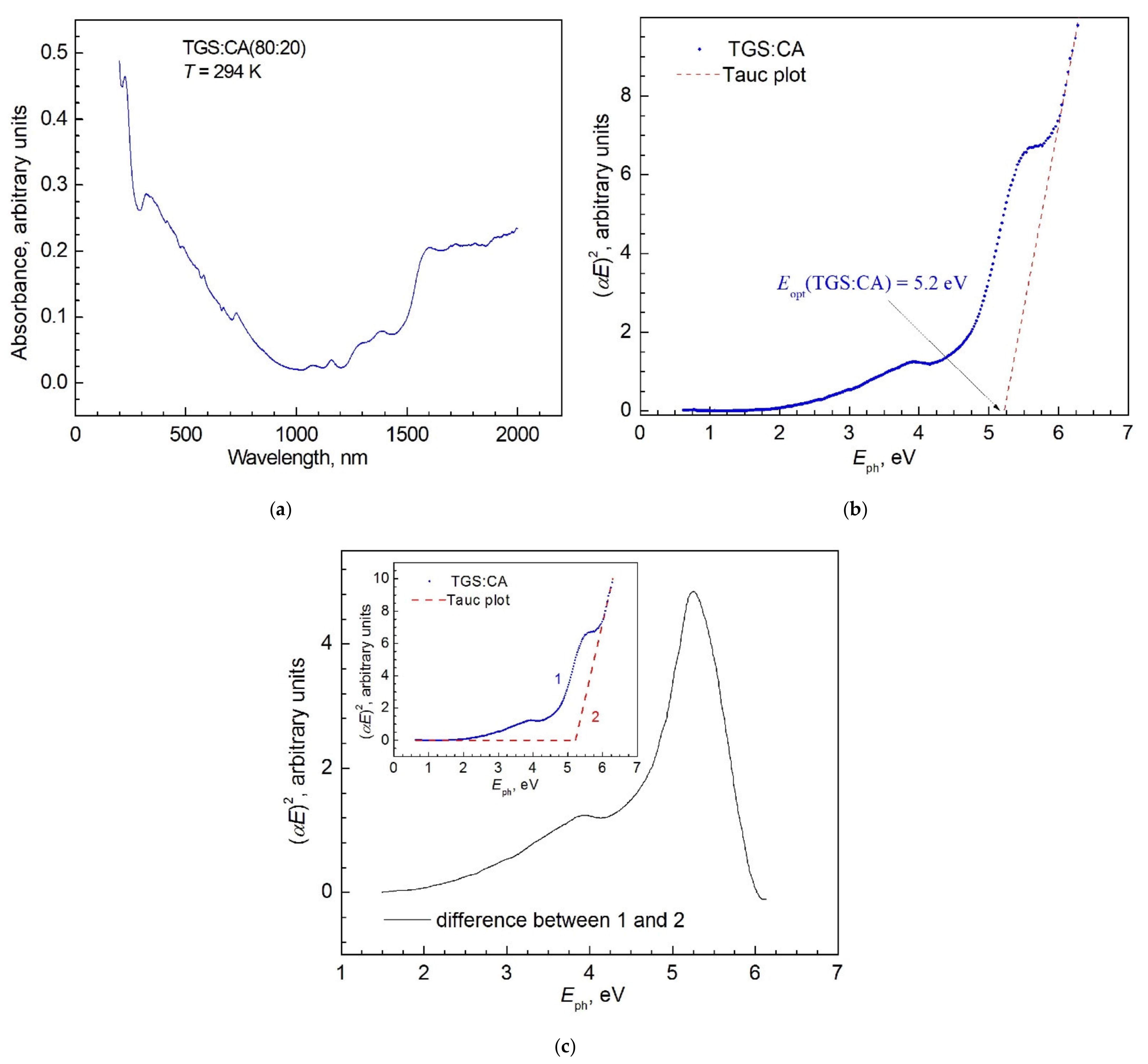

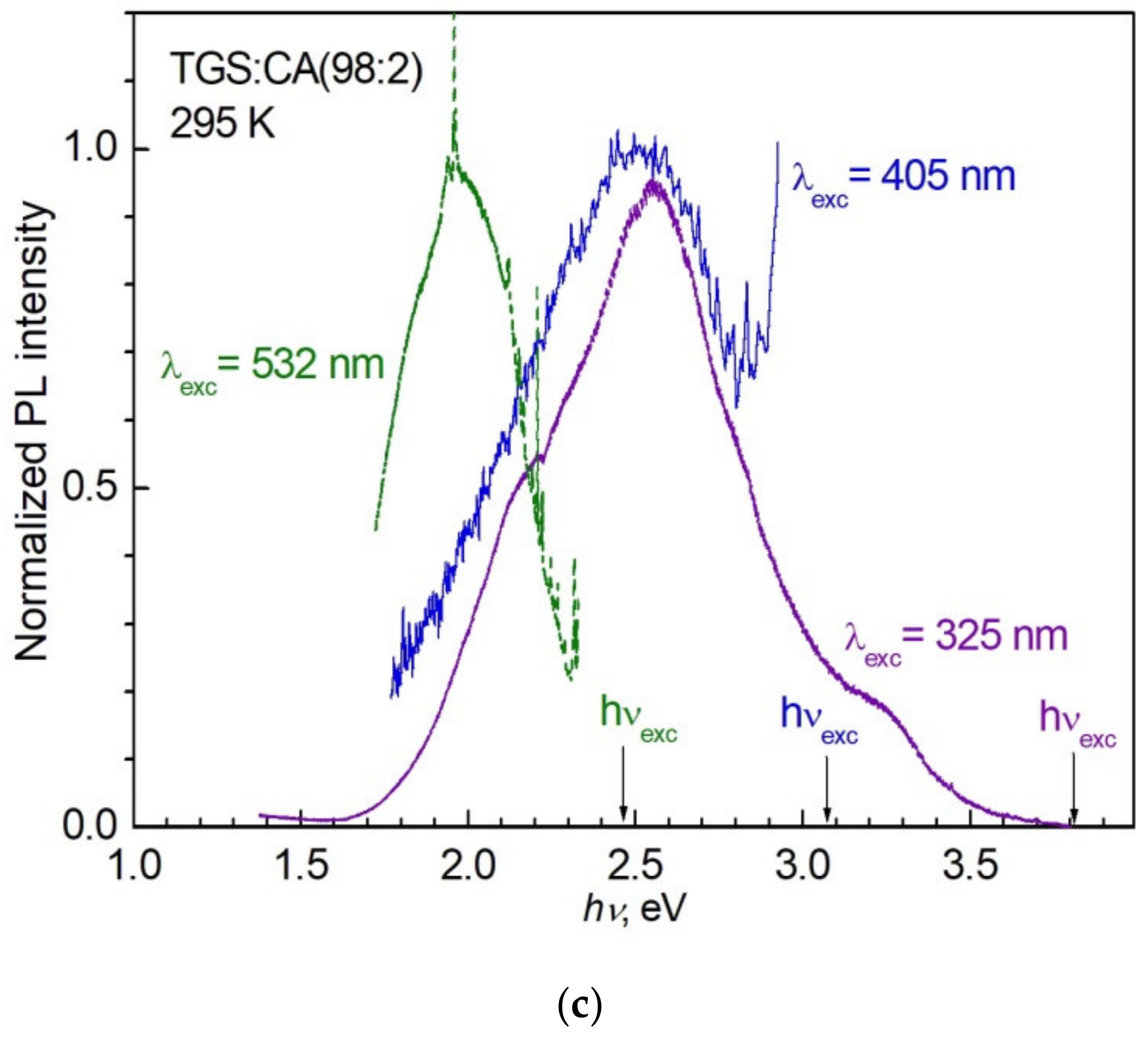
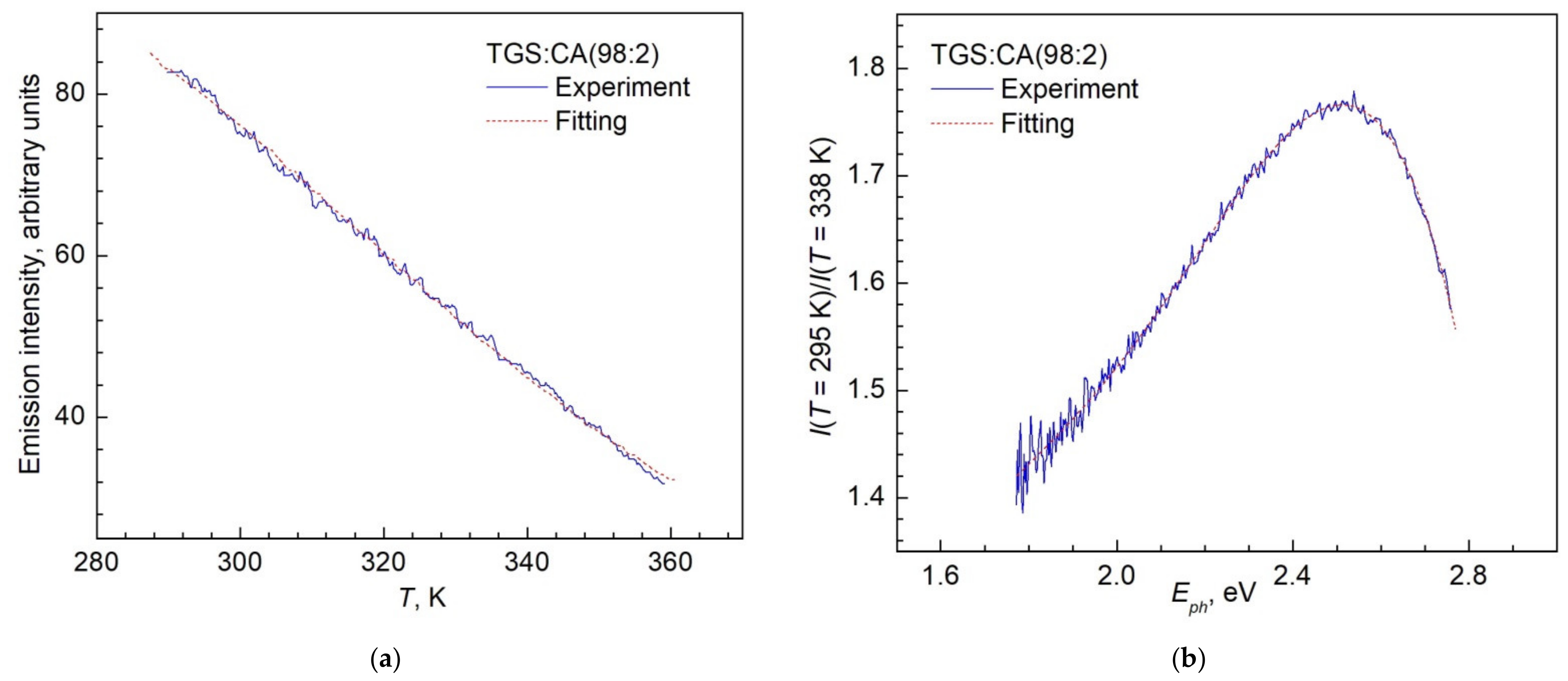
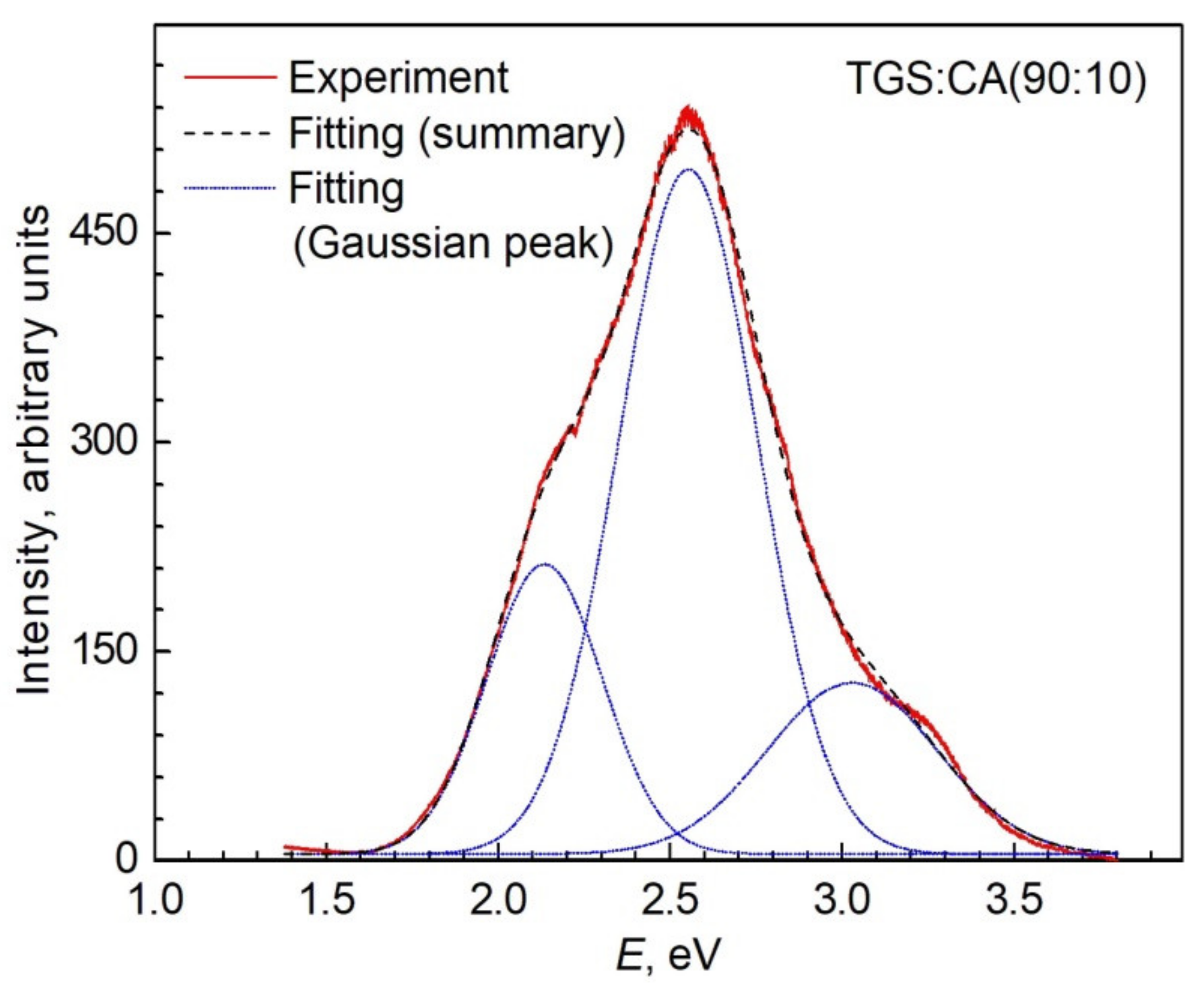
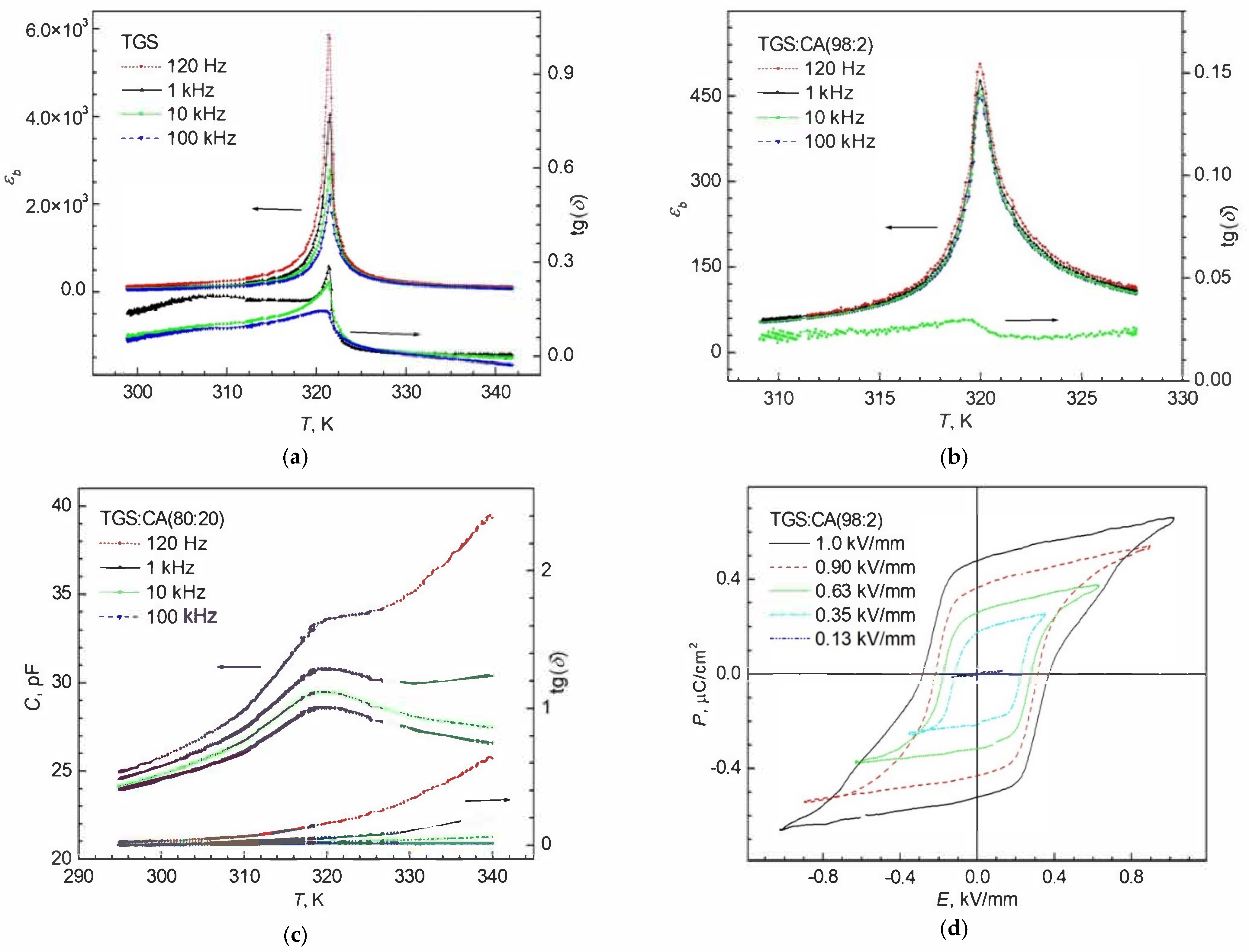
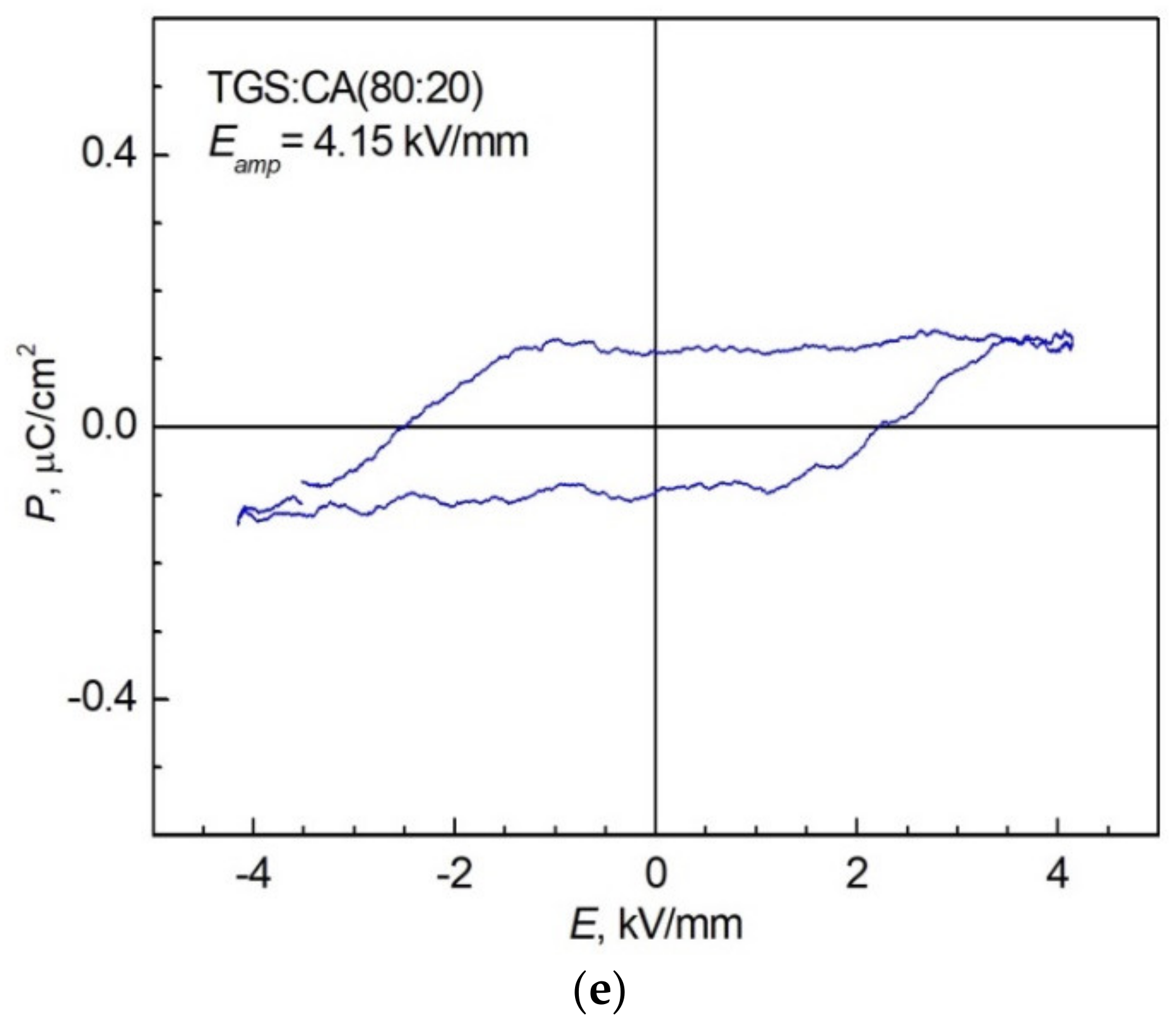
| - | TGS:CA (90:10) | TGS:CA (80:20) |
|---|---|---|
| Chemical formula | C6H17N3O10S | C6H17N3O10S |
| Formula weight, Da | 323.28 | 323.28 |
| Crystal system | Monoclinic | Monoclinic |
| Space group | P21 (4) | P21 (4) |
| a, Å | 9.440(9) | 9.402(2) |
| b, Å | 12.646(14) | 12.623(4) |
| c, Å | 5.738(6) | 5.7304(14) |
| β, ° | 110.19(5) | 110.144(13) |
| V, Å3 | 642.9(1.2) | 638.5(3) |
| Z | 2 | 2 |
| Dcalc, g cm−3 | 1.670 | 1.682 |
| F(000) | 340.0 | 340.0 |
| μ, mm−1 | 0.310 | 0.312 |
| Radiation (λ, Å) | Mo-Kα (0.71073) | Mo-Kα (0.71073) |
| Θ max, o | 29.999 | 26.445 |
| h, k, l max | 13, 17, 8 | 11, 15, 7 |
| Reflections collected | 6425 | 7430 |
| Independent reflections | 3482 | 2596 |
| Data/restraints/parameters | 3482/1/190 | 2596/1/193 |
| GoF | 1.046 | 1.081 |
| Final R indexes (Reflections I >=2σ(I)) | R1 = 0.0595, wR2 = 0.1604 (2981) | R1 = 0.0321, wR2 = 0.0794 (2322) |
| Final R indexes [)Reflections all) | R1 = 0.0674, wR2 = 0.1709 (3482) | R1 = 0.0379, wR2 = 0.0829 (2596) |
| Largest diff. peak/hole, e∙Å−3 | 0.49/−0.43 | 0.23/−0.29 |
| Temperature of measurements, K | 298 | 296 |
| TGS:CA (90:10) | TGS:CA (80:20) | |||||||
|---|---|---|---|---|---|---|---|---|
| Gly ion | α OI-CI-O’I | β OI-CI-CNI | γ O’I-CI-CNI | φ NI-CI-CNI | α | β | γ | φ |
| I | 125.3(4) | 113.5(3) | 121.1(4) | 111.7(3) | 125.1(3) | 113.4(3) | 121.5(3) | 111.8(3) |
| II | 127.2(5) | 110.2(5) | 122.6(4) | 110.8(4) | 126.4(5) | 111.5(5) | 122.1(4) | 111.5(4) |
| III | 125.2(5) | 114.7(5) | 120.1(4) | 111.6(4) | 125.1(5) | 113.9(5) | 120.9(4) | 111.4(4) |
| Sample | Rwp (%) Rp (%) | cRwp (%) cRp (%) | RB (%) me.s.d. | DTOPAS (nm)a | DSizeCr (nm) |
|---|---|---|---|---|---|
| TGS | 7.67 5.65 | 12.64 11.12 | 2.63 3.47 | 65.9(7) | 78(22) |
| TGS:CA (90:10) | 5.11 3.86 | 12.54 12.57 | 1.87 4.51 | 76.5(1.7) | 77(21) |
| a, Å α, o | b, Å β, o | c, Å γ, o | V, Å3 | Remark |
|---|---|---|---|---|
| 9.4323(7) 90 | 12.6584(3) 110.359(7) | 5.7514(3) 90 | 643.8(1) | TSG. Powder XRD (measurements at 313 K). Rietveld fitting. Structure model of [62]. |
| 9.4261(9) 90 | 12.6516(4) 110.349(9) | 5.7475(4) 90 | 642.6(1) | TSG:CA(90:10). Powder XRD (measurements at 313 K). Rietveld fitting. Structure model of this work (Table S1.3. of Supplementary Materials). |
| Scheme | Atom | ||||
|---|---|---|---|---|---|
| S | O | N | C | H | |
| TGS | 0.0386(7) | 0.0376(5) | 0.028(1) | 0.030(1) | 0.042(7) |
| TGS:CA (90:10) | 0.0333(7) | 0.0346(5) | 0.041(1) | 0.029(1) | 0.058(7) |
| Sample | a, Å Δa/a, % | b, Å Δb/b, % | c, Å Δc/c, % | β, o Δβ/β, % | V, Å3 ΔV/V, % |
|---|---|---|---|---|---|
| TGS powder | 9.4323(7) 0 | 12.6584(3) 0 | 5.7514(3) 0 | 110.359(7) 0 | 643.8(1) 0 |
| TGS:CA (90:10) powder | 9.4261(9) 0.066(12) | 12.6516(4) 0.054(4) | 5.7475(4) 0.068(9) | 110.349(9) 0.009(10) | 642.6(1) 0.19(2) |
| TGS:CA (90:10) single crystal | 9.440(9) −0.082(96) | 12.646(14) 0.098(96) | 5.738(6) 0.23(10) | 110.19(5) 0.153(46) | 642.9(1.2) 0.14(19) |
| TGS:CA (80:20) single crystal | 9.402(2) 0.32(2) | 12.623(4) 0.28(2) | 5.7304(14) 0.365(25) | 110.144(13) 0.195(13) | 638.5(3) 0.82(5) |
| No | Raman TGS Lines ν, cm−1 | Raman TGS:CA (90:10) Lines ν, cm−1 | FTIR TGS Lines ν, cm−1 | FTIR TGS:CA (90:10) Lines ν, cm−1 | Assignment |
|---|---|---|---|---|---|
| 1 | 3165b | 3205–3161b | 3224–3106b | νN–H | |
| 2 | 3149(2)b | 3139b | |||
| 3 | 3125b | 3127b | |||
| 4 | 3021(3)s | 3021m | (3026–2900)b | νasCH2 | |
| 5 | 3007m | 3008w | νasCH2 | ||
| 6 | 2986(8)vs | 2988s | νsCH2 | ||
| 7 | 2962vs | 2965m2962 | νsCH2 | ||
| 8 | 2923b | νNH in NH3+ | |||
| 9 | 2857–2847b | “ | |||
| 10 | 2736w | “ | |||
| 11 | 2632w | “ | |||
| 12 | 1876b | ||||
| 13 | 1742m1738w | 1738w | |||
| 14 | 1705(7)m | 1705(7)w | 1715m | 1713m | νs C=O |
| 15 | 1672(5)m | 1672(5)w | 1674w | νC=O | |
| 16 | 1647w | 1646w | 1649w | νC=O | |
| 17 | 1642w | 1637w | δas NH3+ | ||
| 18 | 1622w | 1620m | 1618m | νas (COO−) | |
| 19 | 1607m | 1606(9)m | δas NH3+ | ||
| 20 | 1538(6)m | 1535w | 1543s | 1549m | δNH2 |
| 21 | 1512w | 1512s | δ (NH3)+ | ||
| 22 | 1482(7)m | δ CH2 | |||
| 23 | 1462w | 1462w | δ NH3+ | ||
| 24 | 1442s | 1440m | 1439s | δ CH2 | |
| 25 | 1424m | 1425w | 1429s | δ CH2 | |
| 26 | 1414m | 1414m | 1412m | 1404w | νs COO− |
| 27 | 1371(6)w | 1379m | 1381w | ωCH2 | |
| 28 | 1318(25)m | 1321w | 1327s | 1327s | τ-ωCH2 |
| 29 | 1314(6)w | 1313s | 1313s | τ-ωCH2 | |
| 30 | 1301m | 1301(5)w | τ CH2 | ||
| 31 | 1296sh | τ CH2 | |||
| 32 | 1293(0)w | τ CH2 | |||
| 33 | 1159w | 1161 | 1161sh | γ NH3+ | |
| 34 | 1148s | 1150s | ν3(F2) SO42− | ||
| 35 | 1134(7)m | 1137w | 1128sh | γ NH3+ | |
| 36 | 1114m | 1114w | γ NH3+ | ||
| 37 | 1101m | 1103(99)w | 1093m | 1096s | ν3(F2) SO42− |
| 38 | 1083w | ||||
| 39 | 1065(8)wsh | CA:C–O–H | |||
| 40 | 1043s | 1043(5)m | ν3(F2) SO42− | ||
| 41 | 1035m | 1035w | 1034m | 1036m | ν C–N |
| 42 | 1016m | ||||
| 43 | 1005(7)w | ||||
| 44 | 978vs | 978vs | 986w | 986w | ν1(A1)SO42− |
| 45 | 927w | γ CH2 | |||
| 46 | 909(13)w | 912w | 914m | 916m | γ CH2 |
| 47 | 899(901)s | 899(901)m | γ CH2 | ||
| 48 | 889vs | 889(7)s | 887w | 887w | ν C–C |
| 49 | 867 | 870w | 874 | ν C–C | |
| 50 | 674(9)m | 674w | |||
| 51 | 664m | 664w | δ COO- | ||
| 52 | 634sh | ν4(F2) SO42− | |||
| 53 | 629(31)m | 629w | ν4(F2) SO42− | ||
| 54 | 613m | 611(4)w | ν4(F2) SO42− | ||
| 55 | 581(78)m | 581(78)w | δ C–CO | ||
| 56 | 561m | ||||
| 57 | 497(500)m | 497(500)m | δ C–CO | ||
| 58 | 464(0)m | 462(0)m | ν2(E) SO42− | ||
| 59 | 449s | ν2(E) SO42− | |||
| 60 | 330m | 333m | δ C–C | ||
| 61 | 222w | lattice | |||
| 62 | 207w | “ | |||
| 63 | 179(2)w | “ | |||
| 64 | 161(7)w | “ | |||
| 65 | 126m | 127(8)m | “ | ||
| 66 | 104s | “ | |||
| 67 | 99vs | 97(8)s | “ | ||
| 68 | 76s | 75(6)m | “ | ||
| 69 | 63s | 58(61)m | “ | ||
| 70 | 43m | 42(3)s | “ |
Publisher’s Note: MDPI stays neutral with regard to jurisdictional claims in published maps and institutional affiliations. |
© 2022 by the authors. Licensee MDPI, Basel, Switzerland. This article is an open access article distributed under the terms and conditions of the Creative Commons Attribution (CC BY) license (https://creativecommons.org/licenses/by/4.0/).
Share and Cite
Balashova, E.; Levin, A.A.; Davydov, V.; Smirnov, A.; Starukhin, A.; Pavlov, S.; Krichevtsov, B.; Zolotarev, A.; Zhang, H.; Li, F.; et al. Croconic Acid Doped Triglycine Sulfate: Crystal Structure, UV-Vis, FTIR, Raman, Photoluminescence Spectroscopy, and Dielectric Properties. Crystals 2022, 12, 679. https://doi.org/10.3390/cryst12050679
Balashova E, Levin AA, Davydov V, Smirnov A, Starukhin A, Pavlov S, Krichevtsov B, Zolotarev A, Zhang H, Li F, et al. Croconic Acid Doped Triglycine Sulfate: Crystal Structure, UV-Vis, FTIR, Raman, Photoluminescence Spectroscopy, and Dielectric Properties. Crystals. 2022; 12(5):679. https://doi.org/10.3390/cryst12050679
Chicago/Turabian StyleBalashova, Elena, Aleksandr A. Levin, Valery Davydov, Alexander Smirnov, Anatoly Starukhin, Sergey Pavlov, Boris Krichevtsov, Andrey Zolotarev, Hongjun Zhang, Fangzhe Li, and et al. 2022. "Croconic Acid Doped Triglycine Sulfate: Crystal Structure, UV-Vis, FTIR, Raman, Photoluminescence Spectroscopy, and Dielectric Properties" Crystals 12, no. 5: 679. https://doi.org/10.3390/cryst12050679
APA StyleBalashova, E., Levin, A. A., Davydov, V., Smirnov, A., Starukhin, A., Pavlov, S., Krichevtsov, B., Zolotarev, A., Zhang, H., Li, F., & Ke, H. (2022). Croconic Acid Doped Triglycine Sulfate: Crystal Structure, UV-Vis, FTIR, Raman, Photoluminescence Spectroscopy, and Dielectric Properties. Crystals, 12(5), 679. https://doi.org/10.3390/cryst12050679







